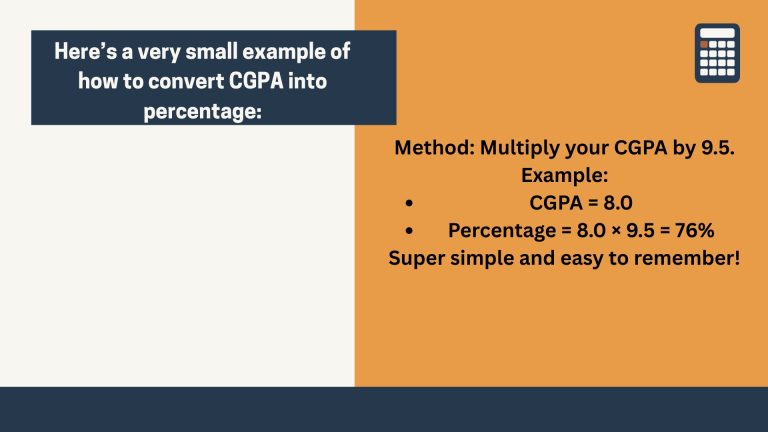How to Calculate CGPA: The Complete Guide for Students
Understanding academic performance measurement is crucial for every student pursuing higher education in India. The Cumulative Grade Point Average (CGPA) system has become the standard evaluation method across universities, replacing traditional percentage-based assessments with a more comprehensive and internationally recognized grading framework.
CGPA represents your overall academic performance throughout your entire degree program, combining individual course grades with credit weightage to provide a holistic view of educational achievement. This system enables fair comparison among students from different academic backgrounds while maintaining transparency in evaluation processes across various Indian universities and educational institutions.
The calculation process involves mathematical principles that account for course difficulty, credit hours, semester-wise performance, and cumulative progress throughout your academic journey. Understanding these fundamentals helps students make informed decisions about course selection, academic planning, and career preparation while ensuring they meet eligibility requirements for scholarships, placements, and higher education opportunities.
Modern Indian universities have adopted standardized approaches to grade calculation, though specific implementation may vary between institutions. The fundamental principles remain consistent: combining individual course performance with appropriate weightage factors to generate accurate representations of academic achievement that reflect both breadth and depth of learning experiences.

Understanding the Indian Grading System Structure
The Indian higher education system predominantly uses a credit-based grading structure that assigns numerical values to letter grades, enabling precise calculation of academic performance across diverse subjects and difficulty levels. This systematic approach ensures consistency and fairness in academic evaluation while providing flexibility for different course structures and learning objectives.
Grade Point Assignment
In Indian universities typically follows a 10-point scale where each letter grade corresponds to specific numerical values. The standard assignment includes: O (Outstanding) = 10 points, A+ (Excellent) = 9 points, A (Very Good) = 8 points, B+ (Good) = 7 points, B (Above Average) = 6 points, C (Average) = 5 points, and P (Pass) = 4 points. Some universities may use variations, but these represent the most common grade point distributions.
Credit Hour System
It assigns weightage to different courses based on their academic intensity, contact hours, and learning objectives. Theoretical courses typically carry 3-4 credits, while practical subjects and laboratory work might have 1-2 credits. Major project work or thesis components often receive higher credit allocations, reflecting their comprehensive nature and extended duration.
Semester-wise Organization
It divides the academic year into distinct periods, usually ranging from 4-6 months each. Most Indian universities follow either semester or trimester systems, with semester systems being more prevalent. Each semester contains multiple courses with varying credit distributions, and students must successfully complete all requirements to progress to subsequent academic levels.
Course Classification
It includes core subjects (mandatory for degree completion), elective courses (chosen based on interest or specialization), and sometimes foundation or bridge courses for students requiring additional preparation. Each category may have different weightage in the overall calculation, with core subjects typically receiving higher priority in degree requirements.
Performance Thresholds
It establish minimum requirements for academic progression, with most universities requiring students to maintain specific grade point averages to avoid academic probation or dismissal. Understanding these thresholds helps students plan their academic strategies and seek assistance when necessary to maintain satisfactory progress.
Basic Mathematical Formula and Calculation Principles
The fundamental mathematics behind CGPA calculation involves weighted averages that account for both performance quality (grades) and course importance (credits). This mathematical framework ensures that courses carrying higher credits or academic significance have proportionally greater impact on overall academic standing.
Core Calculation Formula for individual semester GPA follows: GPA = Σ(Grade Points × Credits) ÷ Σ(Credits), where the summation includes all courses completed in that semester. For example, if you complete four courses with grades and credits of (8,4), (7,3), (9,4), and (6,2), your GPA would be [(8×4)+(7×3)+(9×4)+(6×2)] ÷ (4+3+4+2) = 101 ÷ 13 = 7.77.
Cumulative Calculation Method extends this principle across multiple semesters by treating each semester’s total grade points as a single unit. Calculate total grade points for each semester by multiplying GPA by total credits, sum these values across all semesters, then divide by cumulative credit hours. This approach ensures accurate representation of overall academic achievement.
Weighted Average Principles recognize that semesters with different credit loads should influence the cumulative average proportionally. A semester with 24 credits should have greater impact than one with 16 credits, reflecting the increased academic workload and learning experience. This mathematical approach prevents manipulation and ensures fair representation of academic effort.
Precision and Rounding Standards vary among institutions, with most universities maintaining calculations to two decimal places for official records. Some institutions may use additional precision for internal calculations but round final results for transcript purposes. Understanding your university’s specific precision standards helps ensure accurate record-keeping and calculation verification.
Credit Accumulation Tracking requires maintaining detailed records of completed courses, earned credits, and achieved grades throughout your academic program. This information becomes essential for graduation requirements, transfer applications, and professional opportunities that require academic performance verification.
Step-by-Step Calculation Process with Practical Examples
Understanding the calculation process through detailed examples helps students master the mathematical concepts and apply them confidently to their own academic situations. These practical demonstrations cover various scenarios students commonly encounter during their educational journey.
Single Semester Calculation Example:
Consider a student completing five courses in one semester:
- Mathematics (4 credits): Grade A (8 points)
- Physics (4 credits): Grade B+ (7 points)
- Chemistry (3 credits): Grade A+ (9 points)
- English (2 credits): Grade B (6 points)
- Lab Work (2 credits): Grade A (8 points)
Step 1: Calculate grade points for each course
- Mathematics: 8 × 4 = 32
- Physics: 7 × 4 = 28
- Chemistry: 9 × 3 = 27
- English: 6 × 2 = 12
- Lab Work: 8 × 2 = 16
Step 2: Sum total grade points = 32 + 28 + 27 + 12 + 16 = 115 Step 3: Sum total credits = 4 + 4 + 3 + 2 + 2 = 15 Step 4: Calculate GPA = 115 ÷ 15 = 7.67
Multi-Semester Cumulative Calculation:
Student’s performance across four semesters:
- Semester 1: GPA 7.2, Credits 18, Total Points = 7.2 × 18 = 129.6
- Semester 2: GPA 8.1, Credits 20, Total Points = 8.1 × 20 = 162.0
- Semester 3: GPA 7.8, Credits 19, Total Points = 7.8 × 19 = 148.2
- Semester 4: GPA 8.4, Credits 21, Total Points = 8.4 × 21 = 176.4
Cumulative calculation: Total Points = 129.6 + 162.0 + 148.2 + 176.4 = 616.2 Total Credits = 18 + 20 + 19 + 21 = 78 CGPA = 616.2 ÷ 78 = 7.90
Complex Scenario with Failed and Repeated Courses: Original attempt: Course A (4 credits) – Grade F (0 points) Repeated attempt: Course A (4 credits) – Grade B+ (7 points) Most universities replace the failed grade with the improved grade in calculations, so the contribution becomes 7 × 4 = 28 points instead of 0 × 4 = 0 points.
Variable Credit Distribution Example: Engineering program with diverse course structures:
- Theory Course 1: 4 credits, Grade A+ (9 points) = 36 points
- Theory Course 2: 3 credits, Grade A (8 points) = 24 points
- Laboratory: 2 credits, Grade A+ (9 points) = 18 points
- Seminar: 1 credit, Grade O (10 points) = 10 points
- Project: 6 credits, Grade A (8 points) = 48 points
Total: 136 points ÷ 16 credits = 8.50 GPA
This example demonstrates how project work with high credit allocation significantly impacts overall performance calculations.
Converting Marks and Grades to Grade Points
The conversion process from traditional marks to grade points requires understanding your university’s specific grading scale and conversion criteria. This translation enables accurate calculation within the credit-based system while maintaining the integrity of academic evaluation standards.
Percentage to Grade Point Conversion typically follows established ranges that universities define in their academic regulations. A common scale might assign: 90-100% = 10 points (O grade), 80-89% = 9 points (A+ grade), 70-79% = 8 points (A grade), 60-69% = 7 points (B+ grade), 50-59% = 6 points (B grade), 40-49% = 5 points (C grade), and below 40% = 0 points (F grade).
Letter Grade Translation provides direct conversion from alphabetical grades to numerical grade points according to university-specific scales. Students receiving transcripts with letter grades can use their institution’s official conversion chart to determine appropriate grade points for calculation purposes. This standardization ensures consistency across different evaluation methods within the same institution.
Internal Assessment Integration combines various evaluation components including assignments, quizzes, mid-semester examinations, and final examinations according to predetermined weightage structures. For example, a course might allocate 30% to internal assessments and 70% to final examinations, requiring weighted calculation before grade point assignment.
Practical and Theory Component Separation often occurs in technical and science programs where courses include both theoretical and practical elements. Some universities calculate separate grades for these components, while others integrate them into single course grades. Understanding your program’s specific approach ensures accurate grade point determination.
External Examination Considerations apply particularly to universities using external evaluation systems where independent examiners assess student performance. These systems may require additional steps in converting raw scores to grade points, involving moderation processes and statistical adjustments to maintain fairness across different examination sessions.
Credit-Based Calculation Methods and Weightage Systems
Credit systems provide the foundation for fair academic evaluation by assigning appropriate weightage to courses based on their academic rigor, contact hours, and learning objectives. Understanding these systems enables accurate calculation and proper interpretation of academic performance measures.
Credit Hour Determination reflects the expected student workload for successful course completion, including classroom instruction, laboratory sessions, independent study, and assignment preparation. Universities typically define one credit hour as requiring 15-16 hours of total student engagement per semester, though specific allocations may vary based on course type and instructional methodology.
Course Type Classifications influence credit assignments with lecture courses typically receiving 1 credit per contact hour, laboratory courses receiving 0.5-1 credit per contact hour due to equipment and supervision requirements, and seminar or discussion courses receiving variable credits based on preparation and participation expectations. Major projects and thesis work often receive substantial credit allocations reflecting their comprehensive nature and extended duration requirements.
Weightage Factor Applications ensure that courses with greater academic significance appropriately influence overall performance calculations. Core curriculum courses in a student’s major field typically receive full weightage, while elective courses might receive standard weightage, and foundation courses could receive reduced weightage depending on institutional policies and degree requirements.
Progressive Difficulty Recognition acknowledges that advanced courses require greater intellectual investment and should appropriately influence academic standing. Some universities implement progressive credit systems where introductory courses carry standard credits while advanced and specialized courses receive enhanced credit allocations reflecting their increased complexity and importance to degree objectives.
Interdisciplinary Course Handling addresses situations where students complete courses across different departments or colleges within their university. These courses require careful credit evaluation to ensure appropriate weightage assignment and proper integration into the overall academic record while maintaining degree program coherence and requirements.
University-Specific Calculation Variations Across India
Different universities across India have developed unique approaches to academic performance calculation, reflecting their educational philosophies, student populations, and administrative requirements. Understanding these variations helps students navigate their specific institutional requirements and ensures accurate academic record management.
Central University Standards generally follow University Grants Commission (UGC) guidelines with standardized approaches to credit systems and grade point calculations. Universities like Jawaharlal Nehru University, Delhi University, and Banaras Hindu University maintain comprehensive academic regulations that provide detailed calculation procedures and student guidance resources.
State University Adaptations reflect regional educational priorities and administrative structures while maintaining compatibility with national standards. Universities such as Mumbai University, Pune University, and Calcutta University have developed detailed calculation procedures that account for their diverse student populations and varying academic program structures.
Technical University Specifications address the unique requirements of engineering and technology education, with institutions like VTU, GTU, and KTU implementing specialized calculation methods that account for laboratory work, project components, industrial training, and practical skill development. These universities often provide detailed online resources and calculation tools for student assistance.
Professional Program Considerations apply to specialized fields such as medicine, law, management, and architecture where professional requirements influence academic evaluation. Universities offering these programs often implement modified calculation procedures that reflect professional competency standards and accreditation requirements from relevant professional bodies.
Autonomous College Flexibility allows affiliated colleges to implement variations within their parent university’s framework, providing some adaptation to local conditions while maintaining overall compatibility. Students in autonomous colleges should understand both their college-specific procedures and the broader university standards that govern their degree programs.
Common Mistakes and Calculation Errors to Avoid
Accurate academic calculation requires attention to detail and understanding of institutional procedures. Students commonly encounter specific errors that can significantly impact their academic records and future opportunities, making error prevention essential for academic success.
Credit Hour Miscounting represents one of the most frequent calculation errors, occurring when students incorrectly identify course credit allocations or fail to account for all completed coursework. Always verify credit information from official sources such as course catalogs, transcripts, or academic advisors rather than relying on informal sources or assumptions about standard credit allocations.
Grade Point Misassignment happens when students use incorrect grade-to-point conversions or apply grading scales from different institutions to their current academic work. Each university maintains specific grading scales that must be used for accurate calculations. Obtain official grading information from your current institution and avoid assumptions based on previous educational experiences.
Semester Exclusion Errors occur when students inadvertently omit completed semesters from their calculations or include courses that should not count toward their degree requirements. Maintain comprehensive records of all academic work and consult with academic advisors to ensure proper inclusion of relevant coursework while excluding non-degree courses or transfer credits handled differently.
Repeated Course Handling requires understanding your university’s specific policies for courses that students complete multiple times. Some institutions replace previous grades entirely, others average multiple attempts, and still others use the highest grade achieved. Incorrect handling of repeated courses can significantly impact cumulative calculations.
Precision and Rounding Mistakes can accumulate throughout complex calculations, leading to incorrect final results. Maintain appropriate precision throughout intermediate calculations and apply rounding only at the final step according to your university’s specific standards. Use calculators or software that maintain sufficient precision for accurate academic calculations.
Digital Tools and Calculation Resources
Modern technology provides numerous resources for accurate and efficient academic calculation, ranging from simple online calculators to comprehensive academic management systems. Understanding and utilizing these tools can significantly improve calculation accuracy while reducing time and effort required for academic record management.
University-Provided Calculators offer the most reliable calculation tools as they incorporate institution-specific grading scales, credit systems, and calculation procedures. Most major Indian universities now provide online calculation tools through their student portals or official websites, ensuring compatibility with their specific academic requirements and policies.
Mobile Applications for Academic Management provide convenient access to calculation tools and academic record keeping, allowing students to maintain up-to-date information about their academic progress. Popular educational apps often include features for grade tracking, GPA calculation, academic goal setting, and progress monitoring with synchronization capabilities across multiple devices.
Spreadsheet Templates and Formulas enable students to create personalized calculation tools that can handle complex academic scenarios while maintaining detailed records of their academic history. These templates can be customized for specific university requirements and provide flexibility for handling various calculation scenarios that students might encounter.
Online Calculation Platforms provide general-purpose academic calculation tools that can accommodate various grading systems and institutional requirements. While these tools offer convenience and accessibility, students should verify results using their university’s official procedures and consider potential differences in calculation methods.
Academic Planning Software offers comprehensive solutions for academic record management, degree planning, and calculation tracking throughout a student’s educational journey. These platforms often integrate calculation tools with broader academic planning features, helping students understand how their current performance impacts long-term academic and career goals.
Long-term Academic Planning Using Grade Point Analysis
Strategic academic planning requires understanding how current performance influences future opportunities and developing comprehensive approaches to optimize educational outcomes. Students who master academic analysis can make informed decisions about course selection, study strategies, and career preparation throughout their degree programs.
Performance Trend Evaluation involves analyzing academic performance patterns across multiple semesters to identify strengths, challenges, and improvement opportunities. Students can use this analysis to recognize subject areas requiring additional attention, study methods that align with their learning preferences, and external factors that influence academic achievement. This longitudinal perspective enables proactive academic strategy development.
Goal Setting and Achievement Tracking becomes more effective when students understand the mathematical relationships between current performance and desired outcomes. For instance, students can calculate the required performance levels in remaining semesters to achieve specific cumulative targets, enabling realistic goal setting and strategic planning for academic improvement or maintenance.
Career Requirement Alignment helps students ensure their academic performance meets eligibility criteria for intended career paths, graduate programs, or professional opportunities. Different careers and programs have varying academic requirements, and understanding these expectations early enables appropriate academic planning and performance optimization throughout the degree program.
Risk Assessment and Mitigation Planning enables students to identify potential academic risks and develop strategies to address challenges before they significantly impact overall performance. This proactive approach includes identifying vulnerable subject areas, planning additional support resources, and developing contingency strategies for academic difficulties.
Scholarship and Merit Opportunity Maximization requires understanding how academic performance impacts eligibility for financial aid, merit scholarships, and academic recognition programs. Students can use grade point analysis to position themselves competitively for these opportunities while maintaining realistic expectations about performance requirements and application processes.
Your University’s CGPA Calculators
Choose your university’s specialized CGPA calculator:
Frequently Asked Questions
How do I calculate CGPA for my entire degree program?
Calculate CGPA by finding the weighted average of all your semester GPAs. Multiply each semester’s GPA by its total credits, sum these products, then divide by your total accumulated credits. For example, if you have completed 6 semesters with GPAs of 7.5, 8.0, 7.8, 8.2, 7.9, and 8.1, with 20 credits each, your CGPA would be (7.5+8.0+7.8+8.2+7.9+8.1) ÷ 6 = 7.92.
What’s the difference between GPA and CGPA calculation?
GPA (Grade Point Average) refers to your performance in a single semester, while CGPA (Cumulative Grade Point Average) represents your overall performance across all completed semesters. GPA uses only one semester’s courses and credits, while CGPA uses the weighted average method incorporating all semesters’ worth of academic work.
How do I calculate CGPA from individual course marks?
First, convert your marks to grade points using your university’s grading scale (e.g., 85% might equal 9 grade points). Then multiply each course’s grade points by its credit hours, sum these products, and divide by total credit hours. This gives you the semester GPA. Repeat for all semesters and calculate the cumulative weighted average for your CGPA.
Can I calculate my CGPA if I have failed courses?
Yes, but the method depends on your university’s policy. If you retook and passed the course, most universities replace the failed grade with the new grade in CGPA calculations. If you haven’t retaken failed courses, they typically contribute 0 grade points but still count toward your total attempted credits, lowering your CGPA.
How do I calculate CGPA when different semesters have different credit loads?
Use the weighted average method where semesters with more credits have greater influence on your CGPA. Calculate total grade points for each semester (GPA × credits), sum all grade points, then divide by total credits across all semesters. This ensures semesters with higher credit loads appropriately impact your cumulative average.
What grade point values should I use for different letter grades?
Grade point values vary by university, but a common 10-point scale assigns: O=10, A+=9, A=8, B+=7, B=6, C=5, P=4, F=0. Always check your university’s official grading scale in the academic handbook or student portal, as some institutions use different point assignments or grading scales (4-point, 5-point systems).
How do I calculate my current CGPA if I’m mid-semester?
Calculate using only completed semesters’ data, as mid-semester grades aren’t final. You can project potential CGPA changes based on expected current semester performance, but official CGPA calculations require completed semester results. Use this projection for academic planning and goal setting.
How do credit hours affect my CGPA calculation?
Credit hours act as weightage factors in CGPA calculations. Courses with more credits have greater impact on your overall average. For example, a poor grade in a 4-credit course affects your CGPA more than the same grade in a 1-credit course. This system ensures that more substantial courses appropriately influence your academic standing.
Can I calculate subject-wise or department-wise CGPA?
Yes, use the same calculation method but include only courses from the specific subject or department. Calculate grade points for relevant courses, sum them, divide by relevant credits. This analysis helps identify academic strengths and weaknesses within specific areas of study and can guide academic and career planning decisions.
How do I verify if my CGPA calculation is correct?
Cross-check your calculation by: 1) Verifying all course grades and credits from official transcripts, 2) Using your university’s official calculation method and grading scale, 3) Double-checking arithmetic, and 4) Comparing with online calculators designed for your university’s system. Contact academic advisors if discrepancies persist.
What should I do if my calculated CGPA doesn’t match my transcript?
First, verify you’re using correct grade point values and credit hours from official sources. Check if your university has special policies for repeated courses, transferred credits, or audit courses. If discrepancies remain after verification, contact your university’s examination or records office for clarification and potential correction.
How do I calculate CGPA for engineering programs with lab and theory components?
Engineering courses often combine theory and lab components into single grades, or assign separate grades with specific credit distributions. Use the grades and credits as listed on your transcript. If theory and lab are separate, treat them as individual courses in your calculation with their respective grade points and credit hours.
Can I calculate my CGPA for graduate school applications?
Yes, but some graduate programs may require specific calculation methods or exclude certain course types. Calculate your overall CGPA using standard methods, but also check if target programs have specific requirements such as major-only GPA, last 60 credits GPA, or other specialized calculations. Provide the format requested by each program.
How do I handle transferred credits in CGPA calculations?
Treatment of transferred credits varies by institution. Some universities include converted grades in CGPA calculations, while others exclude transferred courses from GPA calculations but count them toward degree completion. Check your university’s specific policy on transfer credit handling and apply their guidelines consistently.
What’s the minimum CGPA calculation frequency for effective academic planning?
Calculate your CGPA after each semester to monitor academic progress and plan future coursework effectively. This regular calculation helps identify performance trends, assess progress toward academic goals, and make informed decisions about course selection, study strategies, and career planning throughout your degree program.
For more info, visit the main Indian education authority: UGC (University Grants Commission) .


